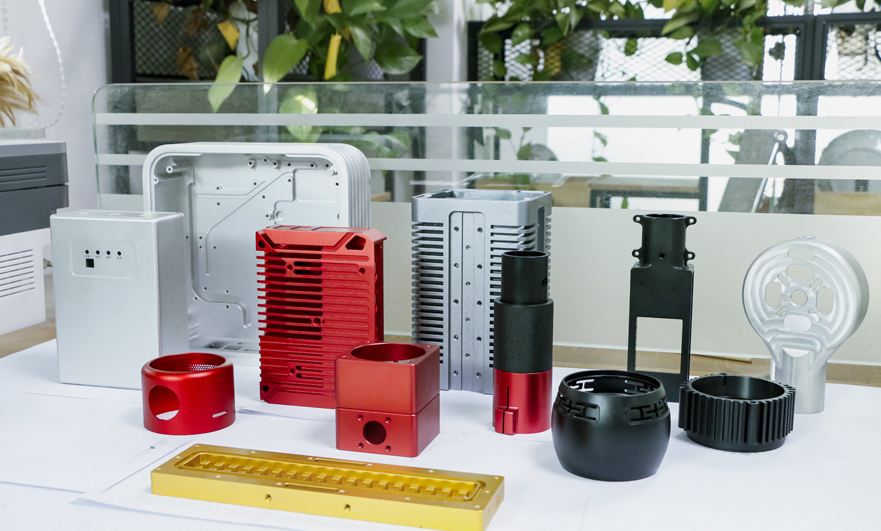15 years one-stop China custom CNC machining parts factory

Hey there I’m VMT Sam!
With 25 years of CNC machining experience we are committed to helping clients overcome 10000 complex part-processing challenges all to contribute to a better life through intelligent manufacturing. Contact us now
 288 |
Published by VMT at Nov 16 2021
288 |
Published by VMT at Nov 16 2021
In this fast-paced era, the consumer electronics industry can be seen everywhere in our life circle. At present, the global consumer electronics industry has a large scale and complex structure. The important infrastructure of consumer electronics products provides fixed, Support, protection and decoration functions, and according to different application environments, have the functions of connectability, shock resistance, heat dissipation, corrosion resistance, interference resistance, and antistatic properties.
Aluminum machined parts are classified according to their purpose, and can be divided into appearance parts, protective parts, shielding parts, and reinforcement parts. From the raw materials used, it can be divided into metal machining parts and injection molding machining parts. Let's follow our VMT engineers to learn about it!
The development of Aluminum machined parts materials for consumer electronics is closely related to the application of aluminum alloy materials in consumer electronics such as notebook computers, tablet computers, and smart phones. Before 2008, although aluminum alloy materials were used in a small range in notebook computers and other equipment, they were mainly concentrated in small components, such as internal supports and fixed structures.
In 2008, Apple officially launched the Macbook series with aluminum unibody body design, introduced a new manufacturing method for notebook products and promoted the continuous improvement of aluminum materials and CNC machining supply chains, leading the aluminum alloy materials The trend of upgrading from small components to structural components; similarly, in 2010, Apple's iPad series tablet computer products designed with aluminum alloy integral molding also achieved unprecedented success.
Compared with the field of notebook computers and tablet computers, the application of aluminum alloy integrated molding design in the field of smart phones is relatively slow. There are three main reasons:
1. Compared with plastic machining parts, aluminum machining parts are more difficult and costly, which will directly affect the selling price of terminal products. Smart phones are updated and replaced more frequently than laptops and tablets, and consumers have more High price sensitivity;
2. Smart phones have a high frequency of use in daily life and consumers have diversified needs for appearance and color. However, the physical properties of Aluminum machined parts determine that it is more difficult to colorize, regardless of color durability There are still technical difficulties in diversification;
3. aluminum machining parts have natural electromagnetic shielding characteristics, and smart phones as communication equipment have higher requirements for the transmission capacity and stability of radio frequency signals.

With the development of technology, the above-mentioned problems are gradually solved. Apple launched its first smartphone iPhone5 in 2012 with an aluminum alloy integrated molding design. It uses anodizing to deal with the dark coloring of aluminum processed parts. It uses the backplane to be hollowed out and filled with ceramic materials to handle RF signal transmission.
Problem: In the same period, mainstream manufacturers also launched One series of high-end smart phones, using aluminum processing parts as the backplane and using injection molding and etching processes to deal with RF signal transmission problems. At this stage, although aluminum processing parts materials are used in the smart phone industry, they are mainly concentrated in high-end models of various brands, and there are also problems such as insufficient wear resistance.
The successful application of aluminum processing parts in consumer electronics products has promoted the development of the entire industry chain, from aluminum alloy manufacturing for consumer electronics, aluminum processing parts material extrusion to subsequent CNC finishing, etching injection molding, anodizing, sandblasting, high gloss, etc. Both the process and scale have been significantly improved.
Compared with plastic machining parts, aluminum machining parts have the advantages of good heat dissipation, strong compression and bending resistance, scratch resistance and scratch resistance, and are more fashionable and beautiful in appearance, thinner and better in texture. They are deeply used in the smart phone industry. Recognized by consumers. Since 2014, aluminum processed parts for consumer electronics have entered a stage of rapid development, unit production costs have gradually decreased, and structural design and production processes have become more mature.
As the next-generation mobile communication technology (5G) has higher requirements for data transmission and the growing wireless charging standard (Qi) technology on the electromagnetic properties of the smartphone backplane material, smartphones under 5G networks are very likely Use non-metallic backplanes such as glass and ceramics. However, compared with metal materials, this type of material still has shortcomings such as insufficient toughness and poor drop resistance.
Therefore, it is more necessary to use high-strength, high-performance mid-frame CNC machining parts for support. Metal machining parts will still be smartphone machining parts The most important part of the At present, the CNC machining parts of smart phones have gradually evolved from the all-metal body design to the metal middle frame structure. The metal materials have also changed from the original 6-series medium-strength aluminum alloy to the more excellent performance of the 6013-series high-strength aluminum alloy and the 7-series aviation-grade aluminum alloy. Or stainless steel upgrade. Since 2017, major mainstream manufacturers have successively launched high-end flagship models of mobile phones with high-strength aluminum alloy middle frame + glass or ceramic backplane design, such as Apple iPhone8/8plus, Samsung GalaxyS8/Note8/S9, Huawei Mate10 and so on.
VMT welcomes everyone to come to our official website for consultation. Of course, you can also send an email to our company mailbox Inquiry@vimetal.com.cn, we will answer your questions as soon as possible. Looking forward to your next aluminum machining parts project.
Ready To Start Your Next Project?
Get Instant Quote

Request a Free Quote
Send us a message if you have any questions or request a quote. We will get back to you ASAP!